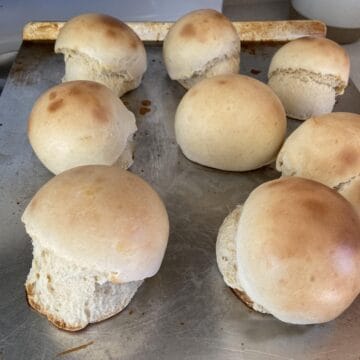
Batangas Bonete Bread (Pan de Bonete) Recipe
Batangas Bonete Bread (Pan de Bonete) is a pre-colonial Filipino bread characterized by its distinctive button mushroom shape, traditionally baked in Batangas province. Named for its hat-like appearance (bonete meaning "hat" in Spanish), this bread features a firm exterior that gives way to a soft, buttery interior. Unlike its more common cousin pandesal, bonete is smaller in size and follows a unique preparation method involving cupcake molds for shaping. The dough incorporates fresh milk, eggs, and butter, yielding a rich taste and tender crumb structure. The finished bread is distinguished by its milk-brushed top, giving it a characteristic sheen, and its compact size makes it ideal for morning or afternoon pairings with traditional Filipino coffee or hot chocolate.
Equipment
- Stand mixer or hand mixer (Para sa pagmamasa / For kneading)
- Large mixing bowl (Mangkok / Mixing bowl)
- Saucepan (Kaserola / Para sa pag-init ng gatas / For heating milk)
- Cupcake tray (Para sa pagporma / For shaping)
- Pastry brush (Para sa paglalagay ng butter at gatas / For brushing butter and milk)
- Kitchen towel (Tela / Para sa pagtatakip habang lumalaki ang masa / For covering during proofing)
- Measuring cups and spoons (Para sa eksaktong sukat / For precise measurements)
- Oven thermometer (Para sa tamang temperatura / For accurate temperature)
Ingredients
For the Dough:
- 3 cups all-purpose flour harina
- 1 teaspoon baking powder pampaalsa
- 1 teaspoon salt asin
Wet Ingredients:
- 160 ml fresh milk gatas
- 2 teaspoon yeast powder lebadura
- ¼ cup white sugar puting asukal
- 75 grams butter cubed at room temperature (mantikilya, hiwain ng parisukat)
- 1 egg itlog
For Toppings:
- Softened butter at room temperature malambot na mantikilya
- Fresh milk for brushing sariwang gatas para sa pagpahid
Instructions
- Start by warming 160ml of fresh milk until it's just warm to touch (about 110°F or 43°C) – think of it as testing baby's milk warm, not hot. Stir in ¼ cup white sugar until it dissolves, then sprinkle 2 teaspoons of yeast over the mixture. Let this rest for 10 minutes until it gets frothy and bubbly – this means your yeast is alive and ready to work.
- While waiting, mix 3 cups of all-purpose flour, 1 teaspoon baking powder, and 1 teaspoon salt in a large bowl. Once your yeast mixture is frothy, pour it into your flour mixture and start mixing with an electric mixer or your hands. Add 1 egg and 75 grams of room-temperature butter (cut into small cubes). Keep mixing for about 20 minutes – the dough will be ready when it feels elastic and smooth, like a baby's cheek.
- Place your dough in a clean bowl and cover it with a clean, dry kitchen towel. Let it rest in a warm spot for 1 hour – your dough should double in size. After an hour, gently punch down the dough and knead it briefly. Divide the dough in half, roll each half into a log, then cut into equal-sized pieces. You should get about 13 pieces total.
- Place each piece into a cupcake tray. Cover them again with your kitchen towel and let them rest for another 30 minutes. While they're resting, preheat your oven to 160°C (320°F). Before baking, brush each dough piece gently with room temperature butter.
- Bake for 15-20 minutes until golden brown. The secret to knowing they're done? They should sound hollow when you tap the bottom. As soon as they come out of the oven, brush the tops with fresh milk – this gives them that signature Bonete shine.
- Serve these little treasures while they're still warm. Watch as the butter melts when you tear them open, and enjoy that first heavenly bite with your morning kape. Store any leftovers (if you have any!) in an airtight container, but trust me, these are best enjoyed fresh from the oven, just like how the old panaderias in Batangas have been serving them for generations.
- Remember: The dough might feel sticky at first, but resist the urge to add more flour unless absolutely necessary. The moisture helps create that perfect texture we're looking for. Also, don't skip the final milk brush – it's what gives Bonete its characteristic finish that sets it apart from other Filipino breads.
Tips from Lola's Kitchen
- Use room temperature ingredients for better incorporation
- The dough should be tacky but not sticky - add flour gradually if needed
- Test yeast activity before using by ensuring it foams in warm milk
- For the perfect mushroom shape, don't flatten the dough too much
- Brush with milk immediately after baking for the signature shine
Nutrition
Calories: 180kcalCarbohydrates: 26gProtein: 4gFat: 7gSaturated Fat: 3gPolyunsaturated Fat: 0.4gMonounsaturated Fat: 1gTrans Fat: 0.2gCholesterol: 26mgSodium: 200mgPotassium: 43mgFiber: 1gSugar: 5gVitamin A: 163IUVitamin C: 0.01mgCalcium: 26mgIron: 1mg
Tried this recipe?Let us know how it was!